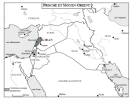The birth of the Islamist movement
The Feda'iyan-e islam movement was born in 1945. There are no exact figures on its number of adherents. It appears to have had several hundred- but this number evolved with their activities and their political alliances. Their strategy of violence is explained in part by a reaction against 'modernisation', encouraged or imposed at that time by the Pahlavi[1] regime, and which affected what was considered the private sphere, such as the unveiling of women or the dress codes, as well as the public domain, such as the control of religious studies.
In 1955 the execution of the founder, Sayyid[2] Mojtaba Mir-Lohi, known under the pseudonym of Navvab Safavi[3] put an end to the activities of the group. After graduation, he worked in the oil industry, at that time largely dominated by the British, in the Abadan region in the south west of Iran. After witnessing an Iranian employee's beating by his boss, he organised a strike in protest and a demonstration, which was followed by a confrontation with the police. Fearing reprisals, he took refuge in Najaf in Iraq [4]where he studied under Ayatollahs[5] Kashif al-Ghita[6] and Abdul-Hussein Amini[7] . It was during this exile that he read the works of the historian Ahmad Kasravi[8] , which criticised Islam and Shi'ism. Navvab Safavi, infuriated by this reading, asked the ulemas for their opinion on Kasravi and took from this that such a person “would deserve to die, according to Islamic law”. Some of them encouraged him to take action by offering financial support. According to Yann Richard, Ayatollah Abdul-Hussein Amini would then have issued a fatwa condemning Kasravi, thus supporting Safavi's plan to kill an intellectual.
Photo of Mojtaba Mirlowhi alias Navvab Safavi Source : Sayyed Hadi KHOSROSHAHI, Feda'iyan-e islâm. Târîkh, amalkardeh, andisheh, Téhéran, Intisharat ittilaat, 2014. | Map of the Middle East Source : Sébastien Angonnet |
After more than three years of exile in Iraq, Safavi returned to Iran where he made contact with Kasravi to persuade him to desist from spreading his ideas, without success. He then turned to violence: a first attempt to assassinate the historian failed and Safavi was imprisoned, then released after pressure from the religious authorities.
It was after his release from prison in 1945 that Safavi founded the jamaat[9] Feda'iyan-e islam. In a statement entitled ' Religion and vengeance', he explained that Islam was under attack and promised revenge for these attacks. In March 1946 several members of the Feda'iyan[10] , including Sayyid Hossein Imami[11] , succeeded in assassinating Kasravi. They were arrested but soon released, once again as a result of pressure from religious circles in Qom and Najaf, in particular from Ayatollah Abu -'L-Qasem Kashani[12] and the Ayatollah based in Najaf, Hajj Agha Hussein Qommi[13] . After this event the movement became more engaged in politics and collaborated with Ayatollah Kashani, who was elected as a Member of Parliament and exiled to Qazwin in 1946. The Feda'iyan campaigned for his return until 1948.










